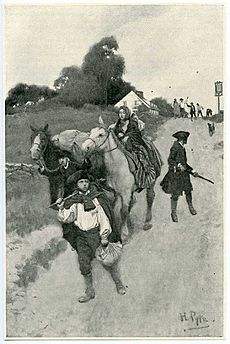Loyalist (American Revolution) facts for kids
Loyalists were people living in the Thirteen Colonies who wanted to stay loyal to the British King and government. They did not support the American Revolutionary War, which was a fight for independence from Britain. Loyalists were also known as Tories.
During the war, Loyalists often fought alongside the British Army against the American revolutionaries. These revolutionaries were sometimes called "Patriots". Patriots believed that the British government was being unfair and "oppressing" them. Because of their loyalty to Britain, many Loyalists faced harsh treatment from the Patriots. Their land and belongings were sometimes taken away, and some were even jailed or killed.
After the war ended, many Loyalists left the newly formed United States. They moved to places like Canada to remain loyal to King George and the British Empire. They sought "asylum", which means they looked for safety and protection in another country.
Contents
Who Were the Loyalists?
Loyalists came from all different backgrounds and jobs. Most of them were regular people like small farmers, skilled workers (artisans), and shopkeepers. Many British officials who worked in the colonies naturally stayed loyal to the King.
Wealthy business owners often remained loyal, as did ministers from the Church of England. This was especially true in Puritan New England, where the Church of England was less common.
Diverse Supporters of the Crown
The Loyalists were a very diverse group. They included some Black people who were promised freedom by the British if they supported them. Native American groups, indentured servants (people who worked for a period to pay off a debt), and some German immigrants also supported the British. The German immigrants often supported the King because King George III himself was of German origin.
The number of Loyalists was different in each colony. For example, about half the people in New York were Loyalists. New York had a more aristocratic (upper-class) culture and was controlled by the British throughout the war. In the Carolinas, farmers in the countryside were often Loyalists, while wealthy plantation owners near the coast usually supported the Revolution.
Loyalists During the War
Most Loyalists did not suffer much just for their beliefs during the war. However, about 19,000 Loyalists actively fought in the conflict. The British provided them with weapons and supplies. These Loyalists formed their own local fighting groups called militias and fought alongside the British Army.
After the War: New Beginnings
The Paris Peace Treaty officially ended the American Revolutionary War. This treaty asked the new American government to give back property that had been taken from Loyalists. For example, the families of William Penn in Pennsylvania and George Calvert in Maryland received good settlements for their lands.
However, in places like the Carolinas, where the fighting between Loyalists and Patriots was very strong, few Loyalists got their property back. In New York and the Carolinas, taking land from Loyalists led to big changes. Large estates were divided and given to smaller farmers, which changed who owned the land.
Leaving the United States
About 100,000 Loyalists left the United States after the war. This included famous people like William Franklin, who was the son of Benjamin Franklin, and John Singleton Copley, a very famous American painter of that time. Most of these Loyalists moved to Canada. For instance, the city of Brantford, Ontario was started by Iroquois Native American refugees who were Loyalists.
Some Loyalists eventually returned to the United States. However, several state governments did not allow them to hold public office. Most of the Black Loyalists left the country because they faced the risk of being enslaved again if they stayed in the USA. For many years after the Revolution, Americans preferred not to talk much about the Loyalists. Except for artists like Copley, Loyalists were often forgotten in American history.
Images for kids
-
A jury finding from Kentucky County, Virginia in July 1780, confiscating lands of two men adjudged to be British subject. Daniel Boone was listed as a member of the jury.
-
Johnson Hall, seat of Sir John Johnson in the Mohawk Valley
-
A Black Loyalist wood cutter at Shelburne, Nova Scotia in 1788
-
Shelburne, Nova Scotia, a major early destination of Loyalist refugees
See also
 In Spanish: Lealista (Guerra de Independencia de los Estados Unidos) para niños
In Spanish: Lealista (Guerra de Independencia de los Estados Unidos) para niños








